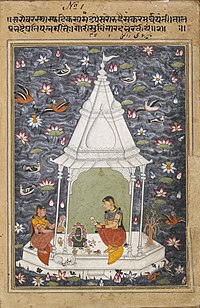Bhairavi (Hindustani)
| Raag Bhairavi | |

| |
| Thaat | Bhairavi |
| Aaroha | Sa Re Ga Ma Pa Dha Ni Sa |
| Avroha | Sa Ni Dha Pa Ma Ga Re Sa |
| Pakad | Ni Sa Ga Ma Dha P Ga Ma Ga Re S |
| Vaadi | Ma |
| Samvaadi | Sa |
| Prahar (Time) | Morning (Pratham Prahar) |
Raag Bhairavi (Hindi: भैरवी) (Template:Lang-ur) (Sindhiراڳ ڀيروي ) is a Hindustani Classical heptatonic (Sampurna) Raag of Bhairavi Thaat. Traditionally it is a morning raga. In modern times, typically in Khyal Gayaki, it is usually performed as the concluding (finale) piece in concerts. It is the defining raga of its own Thaat.
Carnatic music has a Bhairavi raga which is quite different from the Hindustani raga.
Hanumatodi in Carnatic music has the same scale as the Bhairavi in Hindustani music.
Theory
Writing about the musical theory of Hindustani music is fraught with complications. Firstly, there have been no set, formal methods of written notation. Secondly, Hindustani music is an aural tradition, and therefore writing is not an essential part of learning. However, Bhairavi though a morning raag, is now commonly sung at the end of the concert to conclude the concert as 12 notes-Bhairavi exposes the audience with all the notes in the octave. The raag has a child like temperament and the musician is not expected to make the mood sombre. It shares the notes with Bilaskhani Todi which has a sombre temperament.
Arohana & Avarohana
Sa, Komal Re, Komal Ga, Ma, Pa, Komal Dha, Komal Ni,Sa' C, D♭, E♭, F, G, A♭, B♭ , C'
Sa', Komal Ni, Komal Dha, Pa, Ma, Komal Ga, Komal Re , Sa C', B♭, A♭, G, F, E♭, D♭,C
Ranveer sandhu Patiala
Pakad or Chalan
Komal Dha - Komal Ni - Sa
Sa - Komal Re - Sa
Sa - Komal Re - Kali - Ma - Kali - Pa - Komal Ga - Komal Ni - Komal Ga
Organization & Relationships
Related ragas:
Behavior
Behavior refers to practical aspects of the music. It is complicated to talk about this for Hindustani music since many of the concepts are fluid, changing, or archaic. The following information cannot be accurate, but it can attempt to reflect how the music existed. The Performance for this raga is unusually relaxed, some musicians take the liberty of using shuddha Re in ascent, and even the sequence Ma - Teevra Ma. These deviations, however, are not typical of the raga. Musicians are also inclined to sometimes avoid Pa in ascent.
Samay (Time)
Bhairavi is a late morning raag. But it is also used as a concluding piece and as such has been performed even at night, but always in semi or light-classical rendering. If one has to sing or play bhairavi as a main piece it has to be in the morning time.
Seasonality
Bhairavi is one of few raags that can be sung in any season.
Rasa
Raag Bhairavi is typically performed with a peaceful, serious, and occasionally sad mood.
Film Songs
Bhairavi is a popular raga for film songs. Here are some film songs based on Bhairavi:
- Babul Mora Naihar Chhooto Jaye - Street Singer (Kundan Lal Saigal, 1938)
- "Humien Tumse Pyar Kitna" - Kudrat
- "Tu Pyar Kare Yaa Thukraaye" - Dekh Kabeera Roya
- "Dil Apna Aur Preet Paraayi" - Dil Apna Aur Preet Parayi
- "Laga Chunari Main Daag" - Dil Hi To Hai
- "Mata Saraswati" - Aalap (film)
- "Tu Ganga Ki Mauj" - Baiju Bawra
- "Dil to Bachcha hai Ji" - Ishqiya
- "Ramaiya Vasta Vaiiya" - Shree 420
- "Pyar Hua Ekraar Hua Hai" - Shree 420
- "Dil Ke Arman Ansuno Mein Bah Gaye" - Nikaah 1982
- "Sapno Se Bhare Naina " - Luck By Chance
- "Chhod Gaye Balam mujhe haye akela" Lata-Mukesh - Barsaat
- "Socha tha kya kya ho gaya" Suraiya - Anmol Ghadi
- "Barsaat mein hum se mile tum sajan" - Lata Chorus - Barsaat
- "Babul Mora Naihar" - Kavita Krishnamurthy, Gour Hari Dastaan, 2015
- "Mann Mohana" - Jodha Akbar
- "Aaj Phir Tumse Pyaar Aaya Hai" - Hate Story 2
- "mile Sur Mera Thumara"- DD national
- " chingari koi bhadke" - Amar Prem
Historical Information
Origins
Bade Ghulam Ali Khan has asserted that Bhairavi originated in the folk tunes of Iran.[1]
Origin of Bhairavi: The origin of the raga Bhairavi came from one of the oldest Indian Ancient tribe named "Bhirva". And after a long time when Indo-Aryans entered in Ancient India they merged this Non-Aryan Raga into there music & culture. Two books, e.g. "Vabprakashan" by Saradatanay and other "Rag-O-Rup" by Swami Pragyanananda (Page-4) reveal about Ancient "Bhirva" tribe. Nowadays "Bhairavi" raga is being used in worship by Hindus in their religious imagination of "Lord Shiva & Parvati"
References
Bor, Joep (ed). Rao, Suvarnalata; der Meer, Wim van; Harvey, Jane (co-authors) The Raga Guide: A Survey of 74 Hindustani Ragas. Zenith Media, London: 1999.

